

A gold dinar of Huvishka's that does honor to Shiva
Source: http://www.vcoins.com/ancient/cng/store/viewitem.asp?idProduct=4607
(downloaded Apr. 2007)
"Kushan Empire. Huvishka. Circa AD 152-192. AV Dinar (19mm, 7.85 g, 12h). Nimbate, diademed, and crowned half-length bust of Huvishka facing on clouds, head left, holding mace-scepter in right hand, left hand on hilt; flames at shoulder; pellet on cheek / Siva, nimbate, standing facing, head left, pouring water from flask and holding vajra (thunderbolt), trident, and holding a he-goat; tamgha to left."

On this coin Huvishka depicts himself on a very tiny elephant, and the Bodhisattva Vajrapani in the guise of Herakles
Source: http://www.cngcoins.com/Coin.aspx?CoinID=57601&IsEnlarged=1
(downloaded May 2006)
"Kushans. Huvishka I. Circa 152-192 AD. AV Dinar (7.67 gm, 12h). FAONANOFAO
OOHFKI KOFANO, Huvishka riding an elephant right, holding trident in his
right hand, elephant goad in left / hPAKLIO, Eraklio (Herakles) standing
left, wearing lion's skin headdress, holding club in his right hand, uncertain
object in left; tamgha to left. This coin depicts the god Vajrapani, Buddha's
protector, as Herakles, assimilated through Gandharan art via the Parthian
representation of Verethragna as Herakles (see Errington and Cribbs, eds.,
The Crossroads of Asia: Transformation in Image and Symbol in the Art of
Ancient Afghanistan and Pakistan, pg. 132, 134).... Unlike other issues
depicting Vajrapani as Herakles, on this coin the deity wears the lion's
skin rather than holds it. Also, the tamgha on this piece is that of Kanishka,
thus suggesting an early issue of Huvishka."
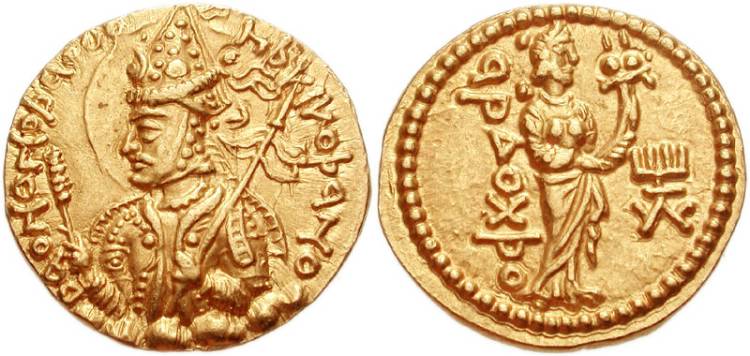
Here, Huvishka honors the Central Asian goddess Ardoxho
Source: http://www.vcoins.com/ancient/cng/store/viewitem.asp?idProduct=4396
(downloaded Feb. 2007)
"Kushan Empire. Huvishka. Circa AD 152-192. AV Dinar (20mm, 7.96 g, 12h). Mint A. Nimbate, diademed, and crowned half-length bust of Huvishka facing, head left, holding mace-scepter and filleted spear over shoulder / APDOXPO, Ardoxsho standing facing, head left, holding laurel branch and cradling cornucopia; tamgha to left."

Another example of a gold dinar honoring Ardoxho
Source: http://www.vcoins.com/ancient/parscoins/store/viewItem.asp?idProduct=2760&large=1
(downloaded Mar. 2006)
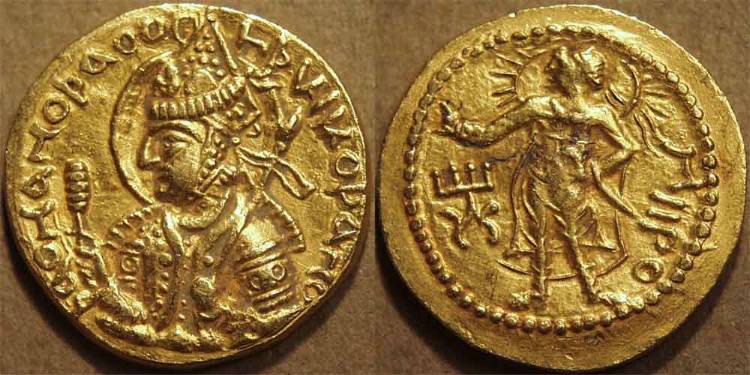
And in this coin, Huvishka honors Miiro, or the Roman god Mithra (akin to the Vedic Mitra)
Source: http://www.vcoins.com/ancient/coinindia/store/viewitem.asp?idProduct=563
(downloaded Jan. 200i)
"Kushan: Huvishka AV dinar. Obverse: King's bust left, nimbate, holding sceptre and mace, Bactrian legend around: þaonanoþao oo...hþki Koþano. Reverse Mithra standing left, radiate, holding sword and granting blessing,Legend at right: MIIPO, Kanishka (!) tamgha at left. Date c. 150-191 CE. Weight 8.02 gm."
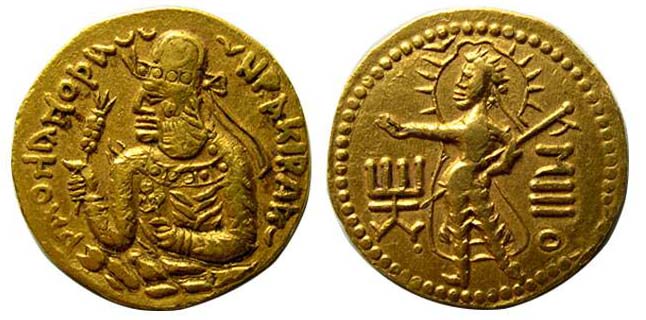
Another gold coin honoring Miiro
Source: http://www.vcoins.com/ancient/parscoins/store/viewItem.asp?idProduct=4134&large=1
(downloaded Dec. 2006)
"Kushan Empire. Huvishka. Circa AD 152-192. AV Dinar (7.81 gm; 21 mm). Mint II (B). Crowned and diademed bust left on clouds, holding mace scepter and sword hilt / Miiro, nimbate and diademed, lunar "horns" at shoulders, standing facing, head left, extending hand in benedictional gesture and cradling globe-tipped scepter; tamgha to left."
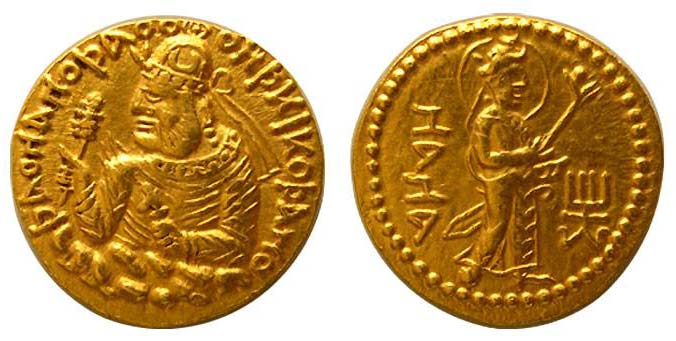
Here, in a continuing show of religious versatility, he honors a god called Nana
Source: http://www.vcoins.com/ancient/parscoins/store/viewItem.asp?idProduct=3597&large=1
(downloaded Sept. 2006)
"Kushan Empire. Huvishka. Circa AD 152-192. Gold Dinar (7.84 gm; 20 mm). Mint II (B). Crowned and diademed bust left on clouds, holding mace scepter and sword hilt / Nana, nimbate, standing right, holding box and scepter."
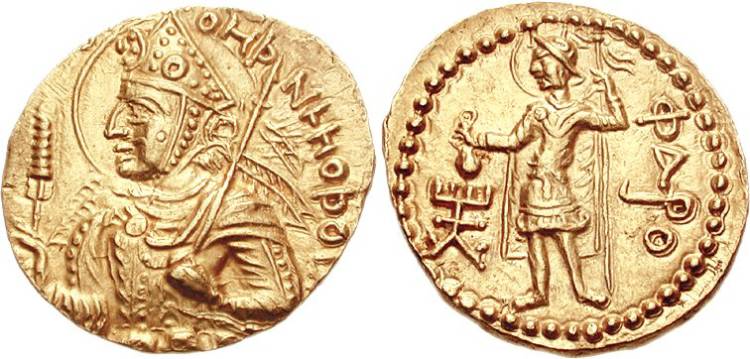
A coin honoring Pharro, or Hermes/Mercury
Source: http://www.vcoins.com/ancient/cng/store/viewitem.asp?idProduct=4441
(downloaded Mar. 2007)
"Kushan Empire. Huvishka. Circa AD 152-192. AV Dinar (22mm, 7.92 g,
12h). Mint B. 3rd emission. Nimbate, diademed, and crowned half-length
bust of Huvishka facing on clouds, head left, holding mace-scepter in right
hand, filleted spear in left over shoulder; pellet on cheek / Pharro (Hermes-Mercury),
nimbate and wearing winged petasos, standing facing, head left, holding
purse in extended right hand and filleted scepter in left; tamgha to left."
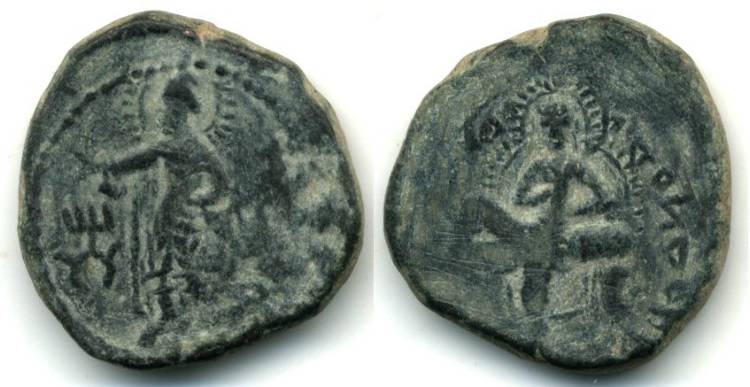
Another coin of Huvishka's that honors the god Pharro
Source: http://www.vcoins.com/ancient/ancientcoinscanada/store/viewItem.asp?idProduct=1728&large=1
(downloaded Oct. 2006)
"Large bronze tetradrachm (?) of Huvishka I (ca.152-192 AD), Kushan Empire. King seated cross-legged, right. Bactrian legend / God Pharro (with very Iranian hairstyle) holding fire in right hand, trident (?) in the left field. 26mm, 14.6 grams."
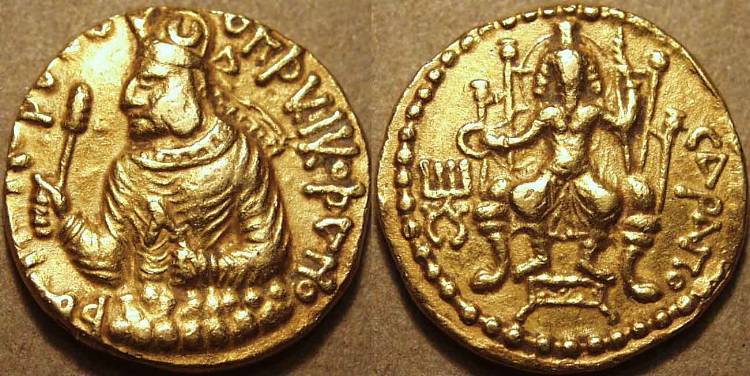
Here Huvishka honors the Hellenistic-Egyptian god Serapis
Source: http://www.vcoins.com/ancient/coinindia/store/viewitem.asp?idProduct=74
(downloaded May 2007)
"Kushan: Huvishka Gold dinar, Serapis reverse. Obverse King's bust left, not nimbate, holding goad and mace, Bactrian legend around: þaonanoþao o...ohþki Koþano. Reverse Serapis seated facing on throne, feet resting on foot-stool, holding diadem and staff, Legend at right: CAPA?O, Kanishka (!) tamgha at left. Date c. 150-191 CE. Weight 7.54 gm. Diameter 19 mm."
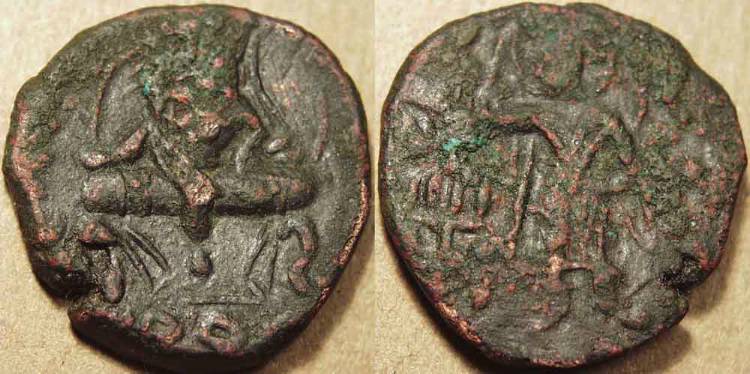
Here Huvishka, seated, honors the moon goddess Mao
Source: http://www.vcoins.com/ancient/coinindia/store/viewitem.asp?idProduct=130
(downloaded June 2007)
"Huvishka AE tetradrachm, King on couch / Mao. Obverse King reclining on couch facing, whole body nimbate, Bactrian legend around: þaonanoþao oo...hþki Koþano. Reverse Lunar deity Mao standing left, lunar crescents on shoulders, holding sword and conferring blessing, Legend at right: MAO, tamgha at left. Date c. 150-191 CE. Weight 9.79 gm. Diameter 23 mm."
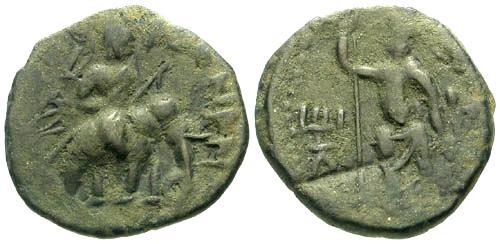
On this coin, Huvishka depicts himself as riding a (very tiny) elephant, and honors the moon goddess Mao
Source: http://www.vcoins.com/ancient/ancientimports/store/viewItem.asp?idProduct=9916&large=1
(downloaded May 2006)
"Kushan Kingdom AE28 Huvishka. Date: 158-195 AD. Obverse: King on elephant
right. Reverse: Lunate moon goddess Mao standing left. Size: 26.34 mm.
Weight: 10.8 grams. Description: A nice example from the Taxila mint."
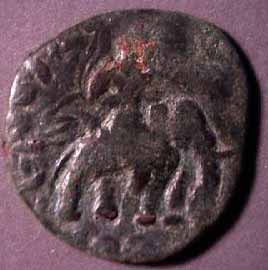 |
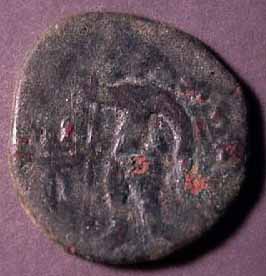 |
A slightly more plausible elephant, and Shiva on the reverse
Source: http://cgi.ebay.com/ws/eBayISAPI.dll?ViewItem&item=3906207158&category=4737
(downloaded Apr. 2004)
"Kushans, Huvishka I. Circa 126-164 AD. AE 26 mm. King seated on elephant
right. Shiva standing left with two arms holding trident."
| == INDIAN ROUTES index == sitemap == Glossary == FWP's main page == |